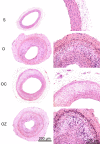Heme oxygenase-1 (HO-1) alleviates vascular restenosis after balloon injury in a rabbit carotid artery model
- PMID: 31938360
- PMCID: PMC6958238
Heme oxygenase-1 (HO-1) alleviates vascular restenosis after balloon injury in a rabbit carotid artery model
Abstract
Percutaneous coronary intervention (PCI) is used commonly for coronary artery disease (CAD); however, restenosis is a proliferative response and frequent sequela to this treatment. Although the introduction of drug-eluting stents has convincingly reduced the incidence of vascular restenosis, restenosis remains a problem. The present study was designed to investigate the effects of the heme oxygenase-1 (HO-1) on restenosis formation after balloon injury in a rabbit carotid artery model. We found that involvement of the HO-1 in defensive restenosis formation was independent of the levels of blood lipid. Activation of HO-1 induced by chlorhematin treatment alleviated vascular restenosis after balloon injury in a rabbit carotid artery model, whereas inhibition of HO-1 by zinc protoporphyrin treatment exacerbated restenosis formation. Furthermore, overexpression of HO-1 inhibited nuclear factor kappa B subunit 1 (NF-кB) activity and decreased tumor necrosis factor-alpha (TNF-α) and endothelin 1 (ET-1) expression. In conclusion, our study provides preliminary data suggesting that HO-1 alleviates vascular restenosis after balloon injury in a rabbit carotid artery model by inhibiting NF-кB, TNF-α and ET-1 expression, indicating induction of HO-1 activation may be a feasible therapeutic target for treating vessels resistant to restenosis.
Keywords: HO-1; activation; balloon injury; restenosis.
IJCEP Copyright © 2018.
Conflict of interest statement
None.
Figures





Similar articles
-
Linagliptin protects rat carotid artery from balloon injury and activates the NRF2 antioxidant pathway.Exp Anim. 2019 Feb 26;68(1):81-90. doi: 10.1538/expanim.18-0089. Epub 2018 Oct 23. Exp Anim. 2019. PMID: 30369549 Free PMC article.
-
Heme oxygenase-1 genotype and restenosis after balloon angioplasty: a novel vascular protective factor.J Am Coll Cardiol. 2004 Mar 17;43(6):950-7. doi: 10.1016/j.jacc.2003.09.058. J Am Coll Cardiol. 2004. PMID: 15028349
-
Clinical restenosis after coronary stent implantation is associated with the heme oxygenase-1 gene promoter polymorphism and the heme oxygenase-1 +99G/C variant.Clin Chem. 2005 Sep;51(9):1661-5. doi: 10.1373/clinchem.2005.051581. Epub 2005 Jul 14. Clin Chem. 2005. PMID: 16020495
-
Heme oxygenase-1 alleviates cigarette smoke-induced restenosis after vascular angioplasty by attenuating inflammation in rat model.Toxicol Lett. 2016 Mar 14;245:99-105. doi: 10.1016/j.toxlet.2016.01.017. Epub 2016 Jan 22. Toxicol Lett. 2016. PMID: 26809138
-
Perspectives of drug-eluting stents: the next revolution.Am J Cardiovasc Drugs. 2002;2(3):163-72. doi: 10.2165/00129784-200202030-00004. Am J Cardiovasc Drugs. 2002. PMID: 14727979 Review.
Cited by
-
H2S attenuates oxidative stress via Nrf2/NF-κB signaling to regulate restenosis after percutaneous transluminal angioplasty.Exp Biol Med (Maywood). 2021 Jan;246(2):226-239. doi: 10.1177/1535370220961038. Epub 2020 Sep 30. Exp Biol Med (Maywood). 2021. PMID: 32996350 Free PMC article.
References
-
- Jolicoeur EM, Belle L, Kelbaek H. Primary PCI with or without thrombectomy. N Engl J Med. 2015;373:682. - PubMed
-
- Hillegass WB. Diabetes is not sufficient justification for IIb/IIIa use in percutaneous coronary intervention. Catheter Cardiovasc Interv. 2015;86:376–377. - PubMed
-
- Kwon JS, Joung H, Kim YS, Shim YS, Ahn Y, Jeong MH, Kee HJ. Sulforaphane inhibits restenosis by suppressing inflammation and the proliferation of vascular smooth muscle cells. Atherosclerosis. 2012;225:41–49. - PubMed
LinkOut - more resources
Full Text Sources
Miscellaneous
